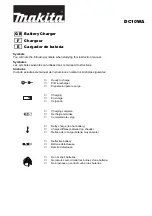
16.
OPERATING INSTRUCTIONS
CONTROLS:
a.
AMMETER
The ammeter shows the total amount of charge the batteries are receiving. The amount each battery receives depends
on several factors (see Parallel Charging). The charger's full output of 110 amps and that amount should never be
exceeded.
b.
VOLTMETER The voltmeter shows the voltage at which the batteries are charging. The amount of voltage applied to a battery will
determine the amount of current the battery will receive. See the section on Charging Batteries for a complete description
of the voltmeter and its use.
c.
SWITCHES
The charger has two switches used to adjust the output voltage and current. Moving the "fine" switch from Lo to Hi does
not increase the charging voltage as much as moving the "coarse" switch from a low position to a higher position. This
design allows you to have 16 distinct charge rates.
CAUTION:
This battery charger must be fully assembled before operating. Failure to do so may result in risk of injury.
TO CHARGE 12 VOLT BATTERIES:
a.
This charger is designed to charge all standard 12 volt automotive batteries.
b.
There are four types of batteries; standard, recombination, low maintenance, and maintenance free.
1.
"Standard" batteries have both negative and positive plates of lead-antimony alloy.
2.
"Recombination" batteries are sealed and have no free electrolyte. The gases produced in charging are "recombined" and recycled
to the plates and separators. If charged at voltages higher than recommended, the gases will not be able to recombine quickly
enough to prevent permanent water loss from the battery.
3.
"Low maintenance" batteries have one plate made from lead-antimony and one made from a lead-calcium alloy. This reduces
gassing and water loss.
4.
"Maintenance free" batteries have both plates made from lead-calcium alloy.
c.
If two types of batteries are to be charged at one time, do not exceed the lower of the recommended end of charge voltages.
d.
As a group of batteries are charged, the output current of the charger will decrease and the output voltage will rise.
e.
For fast charging, keep the voltage adjusted to the top of the acceptable range, being careful not to exceed the current rating of the
charger.
f.
For overnight charging, adjust the voltage at start of charge to be ¾ to 1¼ volts less than the maximum acceptable voltage. As the
current drops, the voltage will climb. The number of batteries, temperature, and the state of charge of the batteries will all effect the
charging characteristics. Experience will be the best teacher when it comes to your particular set of charging circumstances.
g.
If the batteries are to be "float" charged for more than 24 hours, the voltage should be turned down to 13.5 or less to prevent excessive
gassing of the batteries.
PARALLEL CHARGING
a.
Connecting the batteries in parallel (see illustration) allows a person to charge a number of batteries at one time using only one 12 volt
charger.
b.
The amount of charge being put into the batteries should not exceed the rating of the charger.
c.
The amount of charge that each battery receives will depend upon the state of charge, condition, and temperature of all the batteries
being connected together and other factors.
d.
Connecting discharged batteries to a rack of fully charged batteries will not cause the charged batteries to become discharged.
e.
When a rack of batteries have various states of charge, the most discharged battery will receive the largest amount of charge first. Once
it is charged up equal to another battery, then the two will charge together at an equal rate (see illustration).
3























